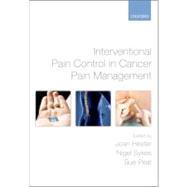
Note: Supplemental materials are not guaranteed with Rental or Used book purchases.
Purchase Benefits
Looking to rent a book? Rent Interventional Pain Control in Cancer Pain Management [ISBN: 9780199219087] for the semester, quarter, and short term or search our site for other textbooks by Hester, Joan; Sykes, Nigel; Peat, Sue. Renting a textbook can save you up to 90% from the cost of buying.
| Contributors | p. ix |
| Setting the scene | p. 1 |
| Difficult pain problems | p. 6 |
| Interventional pain control: Background and current role | p. 20 |
| Mechanisms of cancer pain | p. 40 |
| Neuraxial (epidural and intrathecal) infusions I: Anatomy and commonly used drugs: mode of action, pharmacokinetics, side effects, and evidence base for effectiveness | p. 58 |
| Neuraxial (epidural and intrathecal) infusions II: Patient selection, epidural versus intrathecal, equipment, description of the technique, complications, national use | p. 82 |
| Practical nursing management of epidural and intrathecal infusions | p. 123 |
| Peripheral blocks, plexus blocks, and intrathecal neurolysis | p. 143 |
| Blocks of the autonomic nervous system | p. 171 |
| Cordotomy | p. 203 |
| The use of peripheral nerve and spinal cord neuromodulation in cancer pain | p. 219 |
| Transcutaneous electrical nerve stimulation and acupuncture | p. 235 |
| The patient's perspective | p. 259 |
| Appendix | p. 274 |
| Index | p. 277 |
| Table of Contents provided by Ingram. All Rights Reserved. |
The New copy of this book will include any supplemental materials advertised. Please check the title of the book to determine if it should include any access cards, study guides, lab manuals, CDs, etc.
The Used, Rental and eBook copies of this book are not guaranteed to include any supplemental materials. Typically, only the book itself is included. This is true even if the title states it includes any access cards, study guides, lab manuals, CDs, etc.